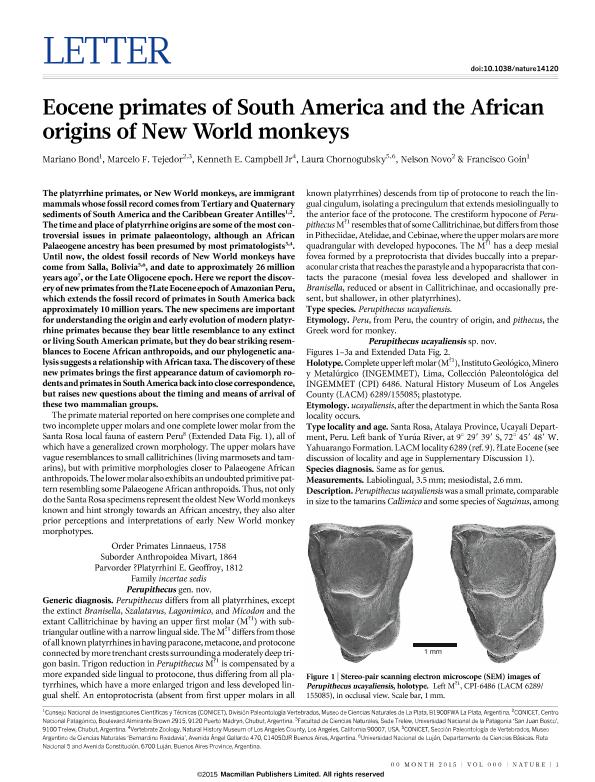Artículo
Eocene primates of South America and the African origins of New World monkeys
Bond, Mariano ; Tejedor, Marcelo Fabian
; Tejedor, Marcelo Fabian ; Campbell Jr, Kenneth E.; Chornogubsky Clerici, Laura
; Campbell Jr, Kenneth E.; Chornogubsky Clerici, Laura ; Novo, Nelson Martin
; Novo, Nelson Martin ; Goin, Francisco Javier
; Goin, Francisco Javier
 ; Tejedor, Marcelo Fabian
; Tejedor, Marcelo Fabian ; Campbell Jr, Kenneth E.; Chornogubsky Clerici, Laura
; Campbell Jr, Kenneth E.; Chornogubsky Clerici, Laura ; Novo, Nelson Martin
; Novo, Nelson Martin ; Goin, Francisco Javier
; Goin, Francisco Javier
Fecha de publicación:
04/2015
Editorial:
Nature Publishing Group
Revista:
Nature
ISSN:
0028-0836
e-ISSN:
1476-4687
Idioma:
Inglés
Tipo de recurso:
Artículo publicado
Clasificación temática:
Resumen
The platyrrhine primates, or New World monkeys, are immigrant mammals whose fossil record comes from Tertiary and Quaternary sediments of South America and the Caribbean Greater Antilles. The time and place of platyrrhine origins are some of the most controversial issues in primate palaeontology, although an African Palaeogene ancestry has been presumed by most primatologists. Until now, the oldest fossil records of New World monkeys have come from Salla, Bolivia, and date to approximately 26 million years ago, or the Late Oligocene epoch. Here we report the discovery of new primates from the ?Late Eocene epoch of Amazonian Peru, which extends the fossil record of primates in South America back approximately 10 million years. The new specimens are important for understanding the origin and early evolution of modern platyrrhine primates because they bear little resemblance to any extinct or living South American primate, but they do bear striking resemblances to Eocene African anthropoids, and our phylogenetic analysis suggests a relationship with African taxa. The discovery of these new primates brings the first appearance datum of caviomorph rodents and primates in South America back into close correspondence, but raises new questions about the timing and means of arrival of these two mammalian groups.
Palabras clave:
Palaeoecology
,
Palaeontology
,
Peru
,
South America
Archivos asociados
Licencia
Identificadores
Colecciones
Articulos(CCT - LA PLATA)
Articulos de CTRO.CIENTIFICO TECNOL.CONICET - LA PLATA
Articulos de CTRO.CIENTIFICO TECNOL.CONICET - LA PLATA
Articulos(CCT-CENPAT)
Articulos de CTRO.CIENTIFICO TECNOL.CONICET - CENPAT
Articulos de CTRO.CIENTIFICO TECNOL.CONICET - CENPAT
Articulos(MACNBR)
Articulos de MUSEO ARG.DE CS.NAT "BERNARDINO RIVADAVIA"
Articulos de MUSEO ARG.DE CS.NAT "BERNARDINO RIVADAVIA"
Citación
Bond, Mariano; Tejedor, Marcelo Fabian; Campbell Jr, Kenneth E.; Chornogubsky Clerici, Laura; Novo, Nelson Martin; et al.; Eocene primates of South America and the African origins of New World monkeys; Nature Publishing Group; Nature; 520; 7548; 4-2015; 538-541
Compartir
Altmétricas



